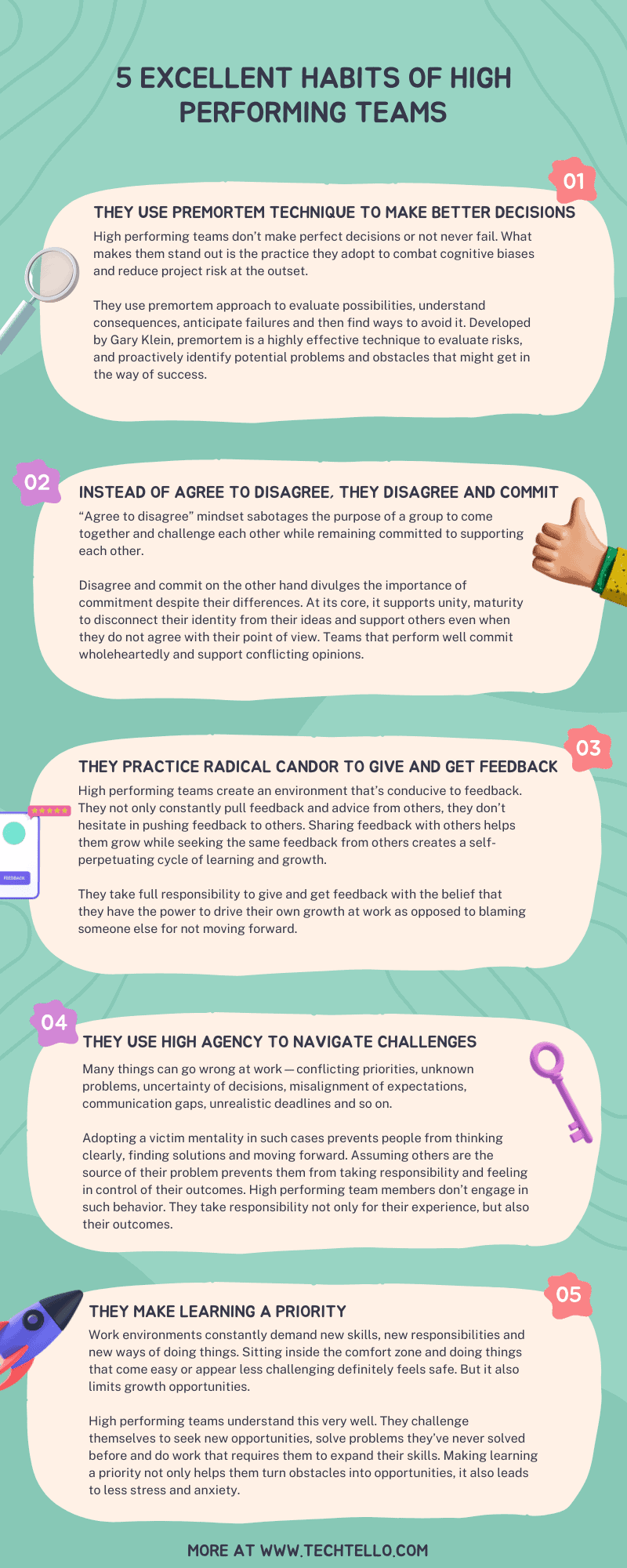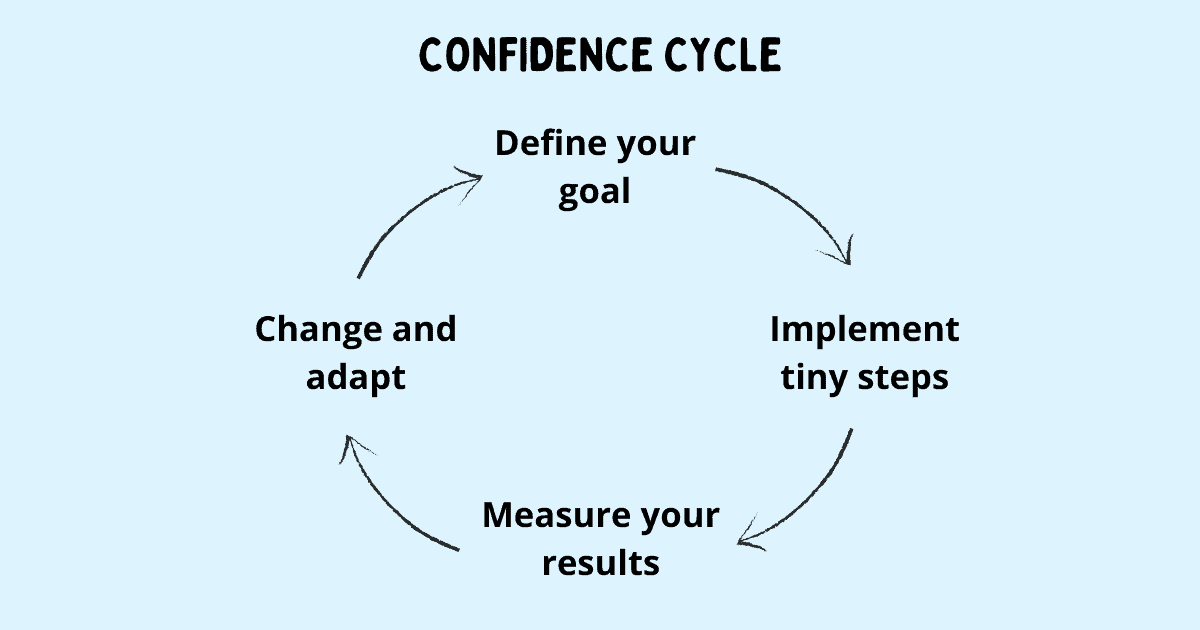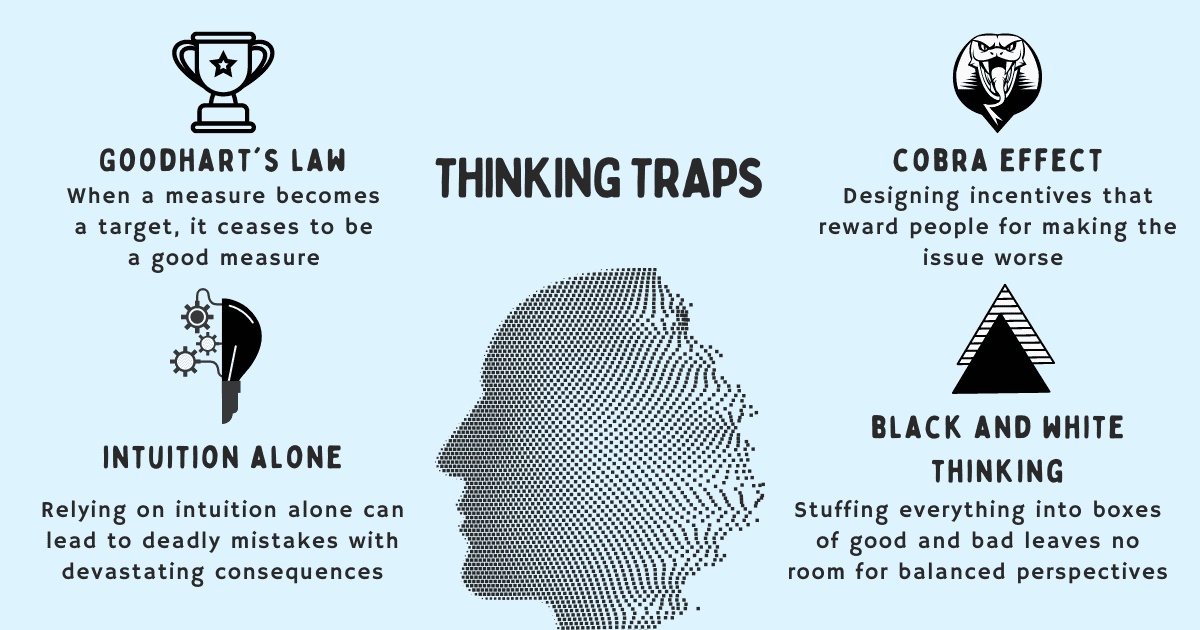5 Excellent Habits of High Performing Teams
What makes some teams do exceptionally well and others to perform poorly? Do they have more talented team members, better resources or are simply being lucky?
Teams that stand out are not more talented, better skilled or have greater opportunities. What sets them apart are their habits and practices.
Empowering work culture, support from leaders in the organization and clarity of vision and goals is important, but they’re not sufficient to drive excellence and high performance in teams.
Building extraordinary workplaces with high performing teams requires more than hiring the right talent and equipping them with the right opportunities. It requires cultivating the right habits and incorporating them into daily work and life.
Here are the 5 habits of high performing teams.
They use premortem technique to make better decisions
Making good decisions is hard. Choices that look good in the moment often fail in the future. In hindsight though, the failure seems evident and clear.
High performing teams don’t make perfect decisions or not never fail. What makes them stand out is the practice they adopt to combat cognitive biases and reduce project risk at the outset.
They use premortem approach to evaluate possibilities, understand consequences, anticipate failures and then find ways to avoid it.
Developed by Gary Klein, premortem is a highly effective technique to evaluate risks, and proactively identify potential problems and obstacles that might get in the way of success.
This is the way it works:
- Place yourself into the future and look back.
- Visualize the project, task or whatever you intend to do has gone horribly wrong.
- Work backwards to identify what mistakes might cause it to fail.
- Create a plan to solve these issues—address the risks and obstacles thereby increasing your chances of success.
The best way to recover from a false start is to avoid one in the first place. And the best technique for doing that is something called a “premortem”.
— Daniel Pink, When
Teams that perform well don’t always make the best choices. They just avoid obvious and bad mistakes.
Instead of agree to disagree, they disagree and commit
What separates a healthy team from an unhealthy one—willingness to openly disagree and yet remaining committed to supporting each other.
When team members agree to disagree, they adopt a negative mindset. Instead of accepting that it’s not about right vs wrong, us vs them, agree to disagree makes them adopt dismissive behavior and ignore the decision. They become non-committal which refrains them from providing the necessary support to others.
“Agree to disagree” mindset sabotages the purpose of a group to come together and challenge each other while remaining committed to supporting each other.
Disagree and commit on the other hand divulges the importance of commitment despite their differences. At its core, it supports unity, maturity to disconnect their identity from their ideas and support others even when they do not agree with their point of view.
It doesn’t hide the fact that they disagree nor dismiss the value of their opinion, it simply guides them to know when it’s time to get past their conviction and work with others instead of working against them.
Instead of turning differences of opinion into a personal agenda where one side must lose for the other to win, high performing team members look beyond their own perspective and treat other people’s ideas worthy of consideration. When a decision doesn’t turn out the way they anticipated, instead of agree to disagree, they disagree and commit.
Each of us tends to think we see things as they are, that we are objective. But this is not the case. We see the world, not as it is, but as we are—or, as we are conditioned to see it. When we open our mouths to describe what we see, we in effect describe ourselves, our perceptions, our paradigms. When other people disagree with us, we immediately think something is wrong with them. But, as the demonstration shows, sincere, clear headed people see things differently, each looking through the unique lens of experience
— Stephen R. Covey, The 7 Habits of Highly Successful People
To disagree and commit, high performing team members do this:
- Separate their identity from their idea.
- Share their intent.
- Inquire into the conflict.
- Evaluate and understand different perspectives.
- State they disagree, yet commit to supporting the decision.
Teams that perform well commit wholeheartedly and support conflicting opinions.
They practice radical candor to give and get feedback
People who don’t get feedback share a common problem—they dump the complete responsibility of giving the right feedback on the feedback giver. Thinking that others are vague, dishonest or unwilling to share feedback makes them ignore the role they play in the equation as the person on the receiving end of the feedback.
Without proper feedback, there’s no way for them to know what they’re doing wrong and what changes will help them learn, improve and get better. Not experiencing the benefits of timely feedback also prevents them from sharing valuable feedback with others.
High performing teams create an environment that’s conducive to feedback. They not only constantly pull feedback and advice from others, they don’t hesitate in pushing feedback to others. Sharing feedback with others helps them grow while seeking the same feedback from others creates a self-perpetuating cycle of learning and growth.
Creating pull is about mastering the skills required to drive our own learning; it’s about how to recognize and manage our resistance, how to engage in feedback conversations with confidence and curiosity, and even when the feedback seems wrong, how to find insight that might help us grow. It’s also about how to stand up for who we are and how we see the world, and ask for what we need. It’s about how to learn from feedback—yes, even when it is off base, unfair, poorly delivered, and frankly, you’re not in the mood
— Douglas Stone, Thanks for the Feedback
They do this by asking these 2 questions to themselves and others:
- How can we work better?
- How can we improve together?
High performing team members take full responsibility to give and get feedback with the belief that they have the power to drive their own growth at work as opposed to blaming someone else for not moving forward.
They use high agency to navigate unknowns and challenges
High agency is about finding a way to get what you want, without waiting for the conditions to be perfect or otherwise blaming the circumstances. High agency people either push through in the face of adversity or they manage to reverse it to achieve their goals. They either find a way, or they make a way.
High Agency is the ability to navigate unknowns and challenging circumstances to carve your own path to success without waiting for the conditions to be perfect. It’s a sense of control over your own behaviors, decisions and actions in shaping up your life as opposed to relying on external circumstances, conditions and environment to decide what you can and cannot do.
Instead of considering other people’s limits as their own limits and fitting inside a box based on what others deem possible, high agency people expand their boundaries of influence, push themselves to navigate the uncharted territory and do the work that’s necessary to succeed.
Many things can go wrong at work—conflicting priorities, unknown problems, uncertainty of decisions, misalignment of expectations, communication gaps, unrealistic deadlines and so on.
Adopting a victim mentality in such cases prevents people from thinking clearly, finding solutions and moving forward. Assuming others are the source of their problem prevents them from taking responsibility and feeling in control of their outcomes.
High performing team members don’t engage in such behavior. They take responsibility not only for their experience, but also their outcomes.
They don’t have special talents or knowledge. What differentiates them is their ability to turn adversity into opportunity. What makes them push ahead when many others pull back is their relentless drive to look for solutions instead of complaining about the problems. When they fail or make mistakes, they feel disappointed much like everyone else, but they don’t let that disappointment get in the way of taking action or making progress.
In The 15 Commitments of Conscious Leadership, Jim Dethmer calls this “taking radical responsibility.” He writes “When we place blame, we locate the cause and control of our lives outside ourselves. When we take responsibility, we locate the cause and control of our lives inside ourselves.”
Circle of Control Workbook
Let go of negativity and rumination by embracing things within your control.
They make learning a priority
Work environments constantly demand new skills, new responsibilities and new ways of doing things.
Sitting inside the comfort zone and doing things that come easy or appear less challenging definitely feels safe. But it also limits growth opportunities. Without experiencing the discomfort that comes with embracing unknowns, without knowing how to navigate complexity and without building the resilience to deal with uncertainty, career growth is impossible to achieve.
High performing teams understand this very well. They challenge themselves to seek new opportunities, solve problems they’ve never solved before and do work that requires them to expand their skills. Making learning a priority not only helps them turn obstacles into opportunities, it also leads to less stress and anxiety.
Just as athletes never quit training, high performers never stop consciously conditioning and strengthening their habits. Real success—holistic, long-term success—doesn’t come from doing what’s natural, certain, convenient, or automatic. Often, the journey to greatness begins the moment our preferences for comfort and certainty are overruled by a greater purpose that requires challenge and contribution. The skills and strengths you have now are probably insufficient to get you to the next level of success, so it’s absurd to think you won’t have to work on your weaknesses, develop new strengths, try new habits, stretch beyond what you think your limits or gifts are.
— Brendon Burchard, High Performance Habits
Summary
- High performing teams proactively identify potential problems, evaluate risks and find ways to overcome obstacles that might get in the way of success. They do this by using the premortem technique.
- They are open in sharing their disagreements, but once a decision has been taken, they show their full support and commitment.
- To perform at their highest levels, high performing team members leverage the power of feedback. They use every opportunity to give and get feedback.
- Instead of blaming others, high performance teams take complete responsibility for their experience and outcomes. High agency gives them a sense of control to move forward instead of feeling stuck.
- They consciously step out of their comfort zone by embracing new opportunities and taking risks. Making learning a priority prepares them to better deal with the challenges and demands of work life.






























